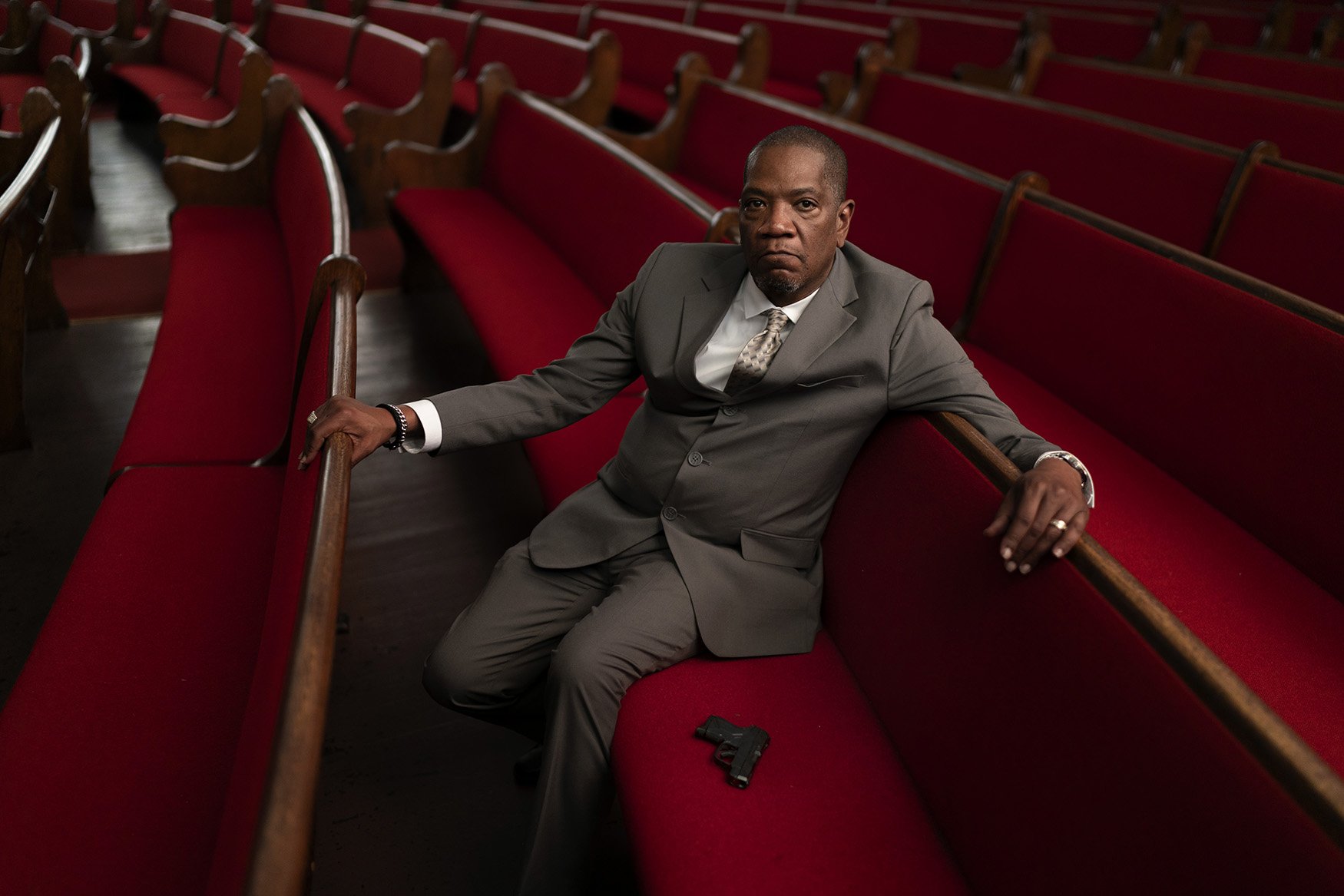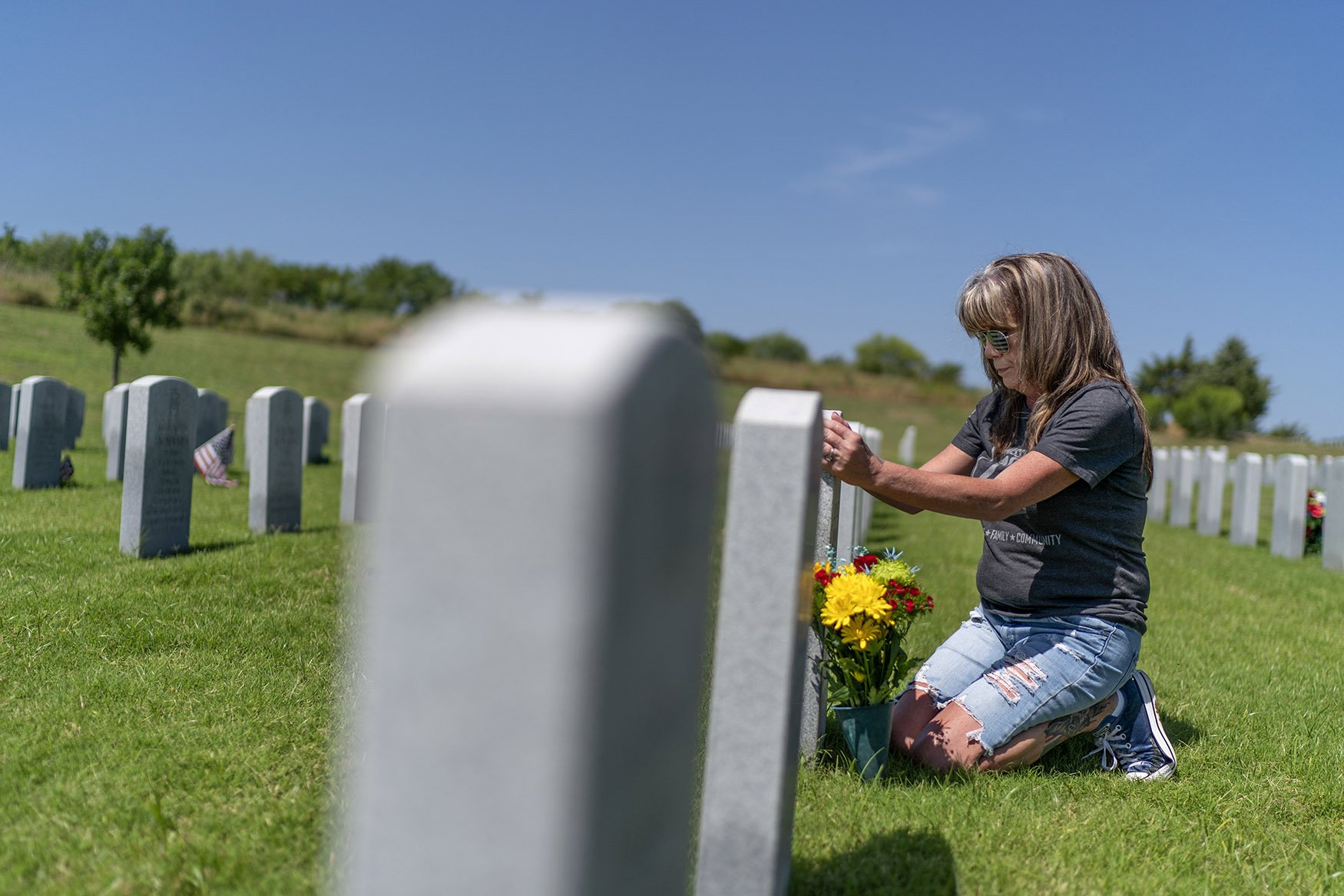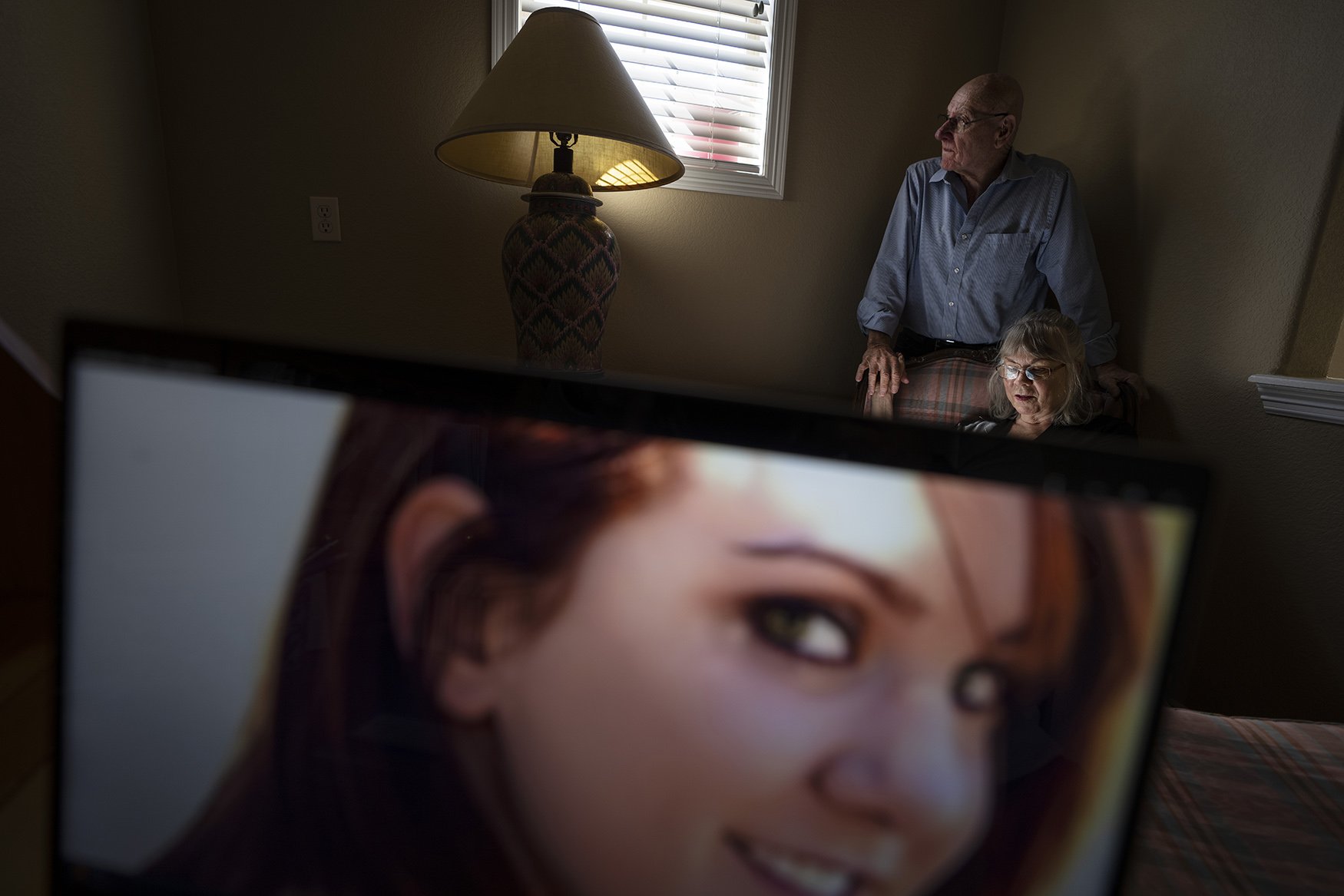For parents who’ve been through shootings, raising kids requires grappling with fears
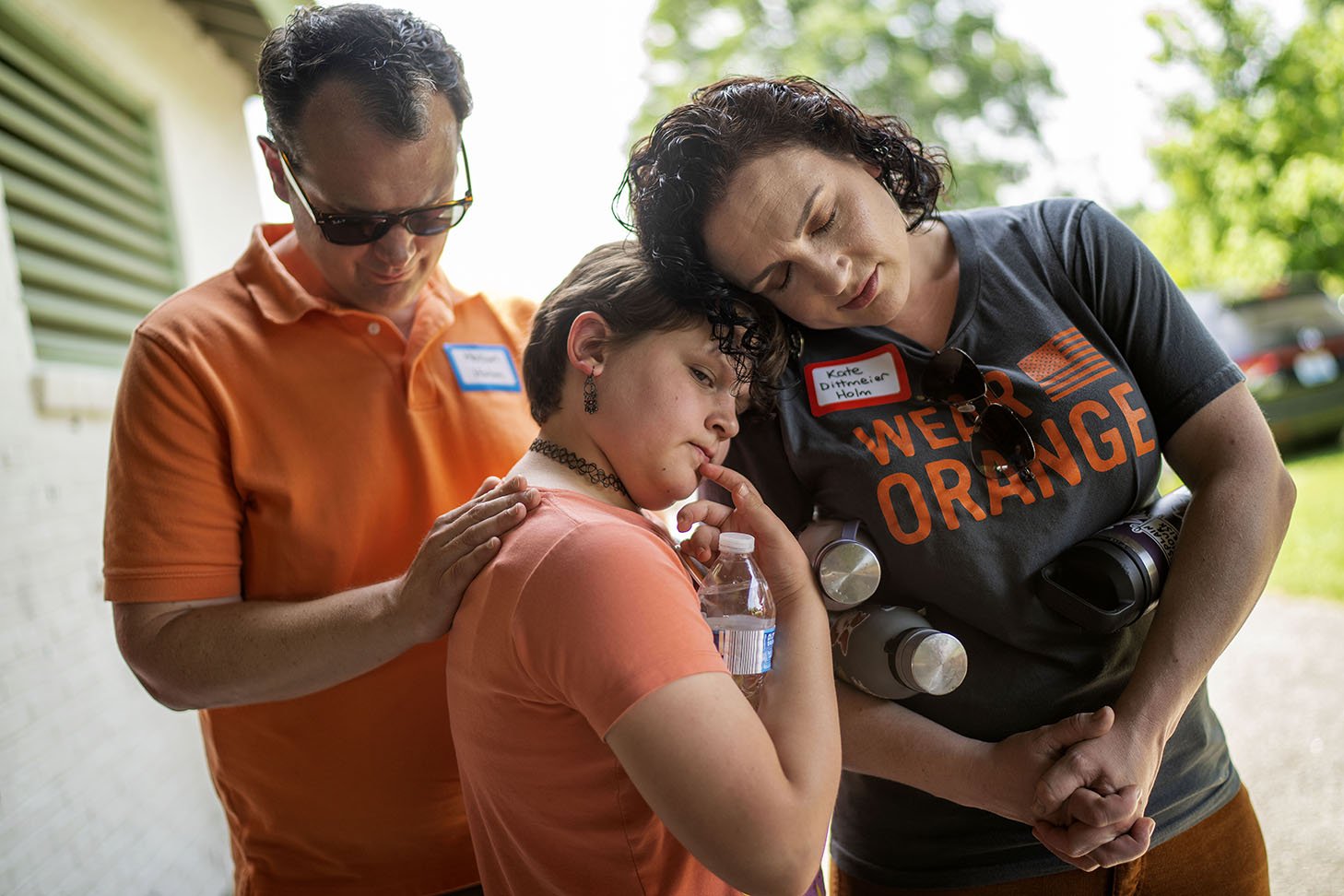
By the time Hollan Holm pulls the family minivan into Chickasaw Park, the buzz rising from a crowd clustered around a large picnic shelter makes clear this afternoon’s story-sharing is already underway.
In the thick heat just outside the pavilion, a youth football coach recounts the grief of losing his 19-year-old son, shot dead in the parking lot of a local liquor store in 2012. Under the rafters, a mother of five, infant son balanced on her hip, recalls her 15-year-old cousin, gunned down just across the park last December.
Holm also carries a story of trauma. But it’s from his own youth, when it was shattered by gunshots.
“Dad, are you speaking today?” asks his daughter, Sylvia, a sixth grader wearing a T-shirt with a picture of Pakistani activist Malala Yousafzai, shot by a Taliban fighter at 15 for asserting girls’ right to an education.
“They’ve got other folks lined up,” says Holm, who a generation ago survived one of the first school mass shootings to shake America’s consciousness.
His son, George, 8, groans.
“Yeah,” Holm says, rolling his eyes. “You guys want to hear me talk.”
They do, actually.
But how can Holm, now 40 and a lawyer for a health care company, make sense for them of what he and classmates in a small Kentucky town endured that long-ago morning?
After a record number of mass killings this year and surging youth deaths by firearms, it can be challenging for any parent to reassure their children and to set aside their own fears.
It can be even harder for those who survived the school shootings of the Columbine era, now that they have children of their own.
“I can’t really go into crowds of people and not be concerned about maybe somebody’s going to do something with a gun … and I don’t want them to have to live like that,” Holm says. “I just want them to be kids.”
More than 25 years and 200 miles separate the violence shadowing today’s protest, in Louisville’s predominantly Black West End, from the school shooting that haunts Holm, who is white. But parental apprehension is common ground.
Heading home, his son’s voice fills the minivan with a gleeful rendition of “Old MacDonald,” when Holm points out the turn to the site of a previous rally. His wife, Kate Dittmeier Holm, notes that it’s just before a gas station where a 44-year-old woman was shot to death recently while trying to break up a fight between customers.
“Why are there so many shootings?” Sylvia says, pleading more than asking.
“That,” her mother says, gently, “is a complex answer.”
A drawing by 11-year-old Sylvia Holm, depicting America's victory over the British in the Revolutionary War, hangs in her home in Louisville, Ky., Saturday, June 3, 2023. (AP Photo/David Goldman)
In the United States, every child has the right to an education.
But ever since a horrific pair of school shootings – the 1989 attack on an elementary school in Stockton, California that killed five students and the massacre of 12 teens and a teacher at Colorado’s Columbine High School a decade later – the question of how to protect children while upholding gun rights has been bitterly contested.
School administrators have worked to “harden” their campuses, adding metal detectors, active-shooter drills and safety officers and, in some cases, encouraging teachers to carry guns. Yet shootings have continued, spotlighting tensions fueled further by U.S. courts' increasingly expansive reading of the Second Amendment.
In a recent poll by the Pew Research Center, about two-thirds of parents said they are very or somewhat worried that there could be a shooting at their child’s school.
For school shooting survivors, the threat can add new anxiety to old trauma, says Frank DeAngelis, who was Columbine’s principal at the time of the massacre and remains in contact with many former students.
“I grabbed my little girl and clenched her to my chest,” one mom, a Columbine survivor, told him on the day her own daughter started kindergarten. “Then I put her down and watched her walk through the doors and I said to myself: Is there a chance she’ll never come home?”
Columbine, at the time the deadliest school shooting in U.S. history, was a watershed, dominating television news and public discourse. But in the months before, several other school shootings had begun raising alarm.
In late 1997, a junior at a high school in Pearl, Mississippi shot and killed two classmates. A few months later, at a middle school near Jonesboro, Arkansas, a pair of students killed five.
Navada Gwynn, right, embraces his daughter, Victoria, 21, while waiting with her at dawn for the bus to take her to work in Louisville, Ky, Tuesday, Aug. 29, 2023. (AP Photo/David Goldman)
It happened, too, at a school tucked between tobacco fields, a half dozen miles outside Paducah, Kentucky.
In December 1997, a 14-year-old freshman walked into the lobby of Heath High School with a .22 caliber pistol in his backpack and four long guns wrapped in blankets. Before the day’s first-period class began, he put plugs in his ears, drew the stolen handgun and started firing on a group of classmates gathered in a morning prayer circle.
Three girls were killed. Nicole Hadley, 14, was a member of the freshman basketball team. Jessica James, 17, played flute in the school band. Kayce Steger, 15, was a member of the school’s Law Enforcement Explorers club, with plans to become a police officer. Five other students were injured.
They included Holm, then 14, scarred by a bullet that grazed the left side of his scalp. It was a very cold morning, he recalls, and when the shooting stopped, someone helped him to a spot near the front doors, his hair matted with blood. In the minutes before ambulances arrived, the muscles in his back tensed uncontrollably as icy air rushed over him.
Hollan Holm, right, locks the front door before heading to dinner with his daughter, Sylvia, 11, and the rest of the family in Louisville, Ky., Saturday, June 3, 2023. (AP Photo/David Goldman)
For years afterward, Holm says, he told himself that the surface wound didn’t justify brooding. More school shootings and the arrival of fatherhood forced him to consider otherwise.
“The more I talked about it the more I would get those same spasms again,” says Holm, whose still boyish face, now framed by a receding hairline, recalls the photo on the front of the Paducah Sun the morning after the shooting. “And I realized there was something I needed to deal with.”
___
Hollan and Kate met when both were students at Western Kentucky University, working together on the campus newspaper. On their first date, Kate recalls trying to figure out why his attention seemed to be elsewhere, not realizing that it was the fifth anniversary of the shooting at Heath.
“It took me years to figure out why Hollan was quiet and in a bad mood on that day,” she says.
Whether or not he wanted to acknowledge the trauma that stemmed from the shooting, though, it remained present.
In restaurants, Hollan made sure to get a chair facing the door, intent on watching for approaching threats. When an unfamiliar man wearing a trench coat and carrying a backpack entered church one Sunday, Hollan tensed up, so alarmed by what the visitor might do that he and Kate had to leave.
The couple had married, graduated from law school together and started a family before he began confronting those feelings in earnest.
Sylvia Holm, 11, right, swings in her backyard while playing with her brother, George, at their home in Louisville, Ky., Saturday, June 3, 2023. (AP Photo/David Goldman)
In 2017, Sylvia, their first child, started kindergarten. At the dinner table that fall, she announced that her class had learned a new drill. First her teacher locked the classroom door and turned off all the lights. Then she instructed the 5-year-olds to stay very quiet, so the “bad person” wouldn’t find them.
“I remember that look on your face – you were just kind of grief stricken,” Kate tells Hollan.
“It just kind of broke my heart,” he says.
That December survivors marked the 20th anniversary of the shooting at Heath with a new memorial for victims. Watching the ceremony live on local television, Holm says, visions of the attack played back in his head.
“I am not OK,” he told himself.
Seven weeks later, a 15-year-old boy opened fire on classmates at western Kentucky’s Marshall County High School, about a 30-minute drive from Heath. He killed two students and injured 14.
Memories sparked by the shooting convinced Holm to sit down with a therapist. Later that year, meeting with Marshall County students, he was struck by how much their stories echoed his own and how little changed.
At protests that followed the 2018 shooting at Florida’s Marjory Stoneman Douglas High School that killed 17, he began speaking out for stronger gun laws.
He didn’t anticipate the way it would affect his family.
In August 2019, Holm was delivering a speech on the steps of the federal courthouse in Louisville when he spotted his wife and 7-year-old daughter in the crowd. For the first time, Sylvia was hearing her father’s story. She looked stricken, her eyes wide with fear.
“She went up to him and she held on tight and the worry on her face, you could see it,” Kate says.
Sylvia has only hazy memories of the first time she heard her father’s story, but she knows how it made her feel: “I can’t even imagine living without Dad.”
Missy Jenkins Smith, a survivor of a school shooting in 1997 which left her paralyzed, poses for a portrait at her home in Kirksey, Ky., Monday, June 5, 2023. (AP Photo/David Goldman)
More than a dozen years after the most traumatic day of her life, Missy Jenkins Smith was thinking only of celebration.
It was her son’s third birthday and she and husband Josh had taken him out to dinner at Chuck E. Cheese. Driving home in the Nissan, fitted to accommodate the disability Missy sustained in the same school shooting that injured Holm, the little boy stayed wide awake.
His parents laughed when he pointed out that his middle name, Brock, was almost the same as the president of the United States. Then, suddenly, the subject of his interest changed.
“Mom, why are you in a wheelchair?” he asked.
“We just looked at each other and it was like we were kind of in shock. How are we going to answer this?” Jenkins Smith recalls. “We knew that day would come, but we never really talked about what we would say.”
Of course, she and Josh tell each other now, they should’ve been prepared. Unlike Holm, Jenkins Smith never had a choice about whether to keep what had happened to her hidden.
Paralyzed from the chest down when one of the shooter’s bullets severed her spinal cord, she had been honest with herself and others about the injury and the circumstances. In a way, talking about it was like therapy, she says.
But that was very different from explaining it to a small child. Her child.
“There were people that died,” she told her son, Logan. “But Mommy lived, and this is what it did to me.”
That seemed to satisfy him, and when Jenkins Smith delivered a speech about her experience five years later, she brought both her sons so they could hear it in full. Still, it remained abstract to them, like a movie or a scary story, she says.
The 2018 shooting at nearby Marshall County High School, which played a role in forcing Holm to confront his trauma, also shook the Jenkins Smith household.
With local airwaves and conversation filled with accounts of the shooting, Logan confided his fears to a teacher. Their fourth-grade classroom had no door and it was right by the entrance to the building, he pointed out. If shooting erupted, he would have to escape through a window.
Missy and Josh tried to reassure him, encouraging him to share his worries rather than hide them. But she, too, was shaken.
Jenkins Smith had long warned educators and students she spoke to that no school was immune from a mass shooting. At the same time, she had told herself that her own community, having endured it once, would be OK.
“That was a scary thing, knowing people that went to Marshall and that I was a parent now,” she says. “It could happen again. We’re not immune. … Those words were true. It was kind of haunting.”
Krista Gwynn shows the text message she received from her daughter, Victoria, when she was shot and injured in 2021 at a park in Louisville, Ky., Tuesday, Aug. 29, 2023. (AP Photo/David Goldman)
In the shade of Chickasaw Park’s pavilion, the Holms and more than 200 others stand with heads bowed, observing one second of silence for each person shot to death in Louisville so far this year.
Seventy-four ticks of the clock – and it’s only June.
“It’s not just the boys I worry about, because no kid is safe,” says Myia Brown, a mother of five, pointing to a spot across the 61-acre park, not far from a marker noting that Muhammad Ali trained here as a teenager.
In December, it was joined by a small white cross wreathed in silk flowers that mourns Brown’s cousin, Ja’Maury Johnson, shot to death near an asphalt lot overlooking the Ohio River. He was 15.
In April, two more people were killed in Chickasaw, including a 17-year-old, and four were injured when someone fired into a crowd.
The violence feels very far from the small-town shooting that scarred Holm and left Jenkins Smith in a wheelchair. All the teens killed or injured in 1997 were white, raised in a county that in some years does not report a single homicide. Most of those shot in Louisville are Black and the toll keeps climbing.
What they share is trauma.
Holm recalls the panic he felt years ago, a few weeks after returning to school, when he mistook the sound of a balloon popping inside a Walmart for gunfire. Even now, sudden, loud noises can bring that feeling back.
The sound of gunshots is not uncommon in some Louisville neighborhoods. But the trauma described by those gathered in the park today is at least as potent.
Nevada, Gwynn, left, embraces his daughter, also named, Navada, 15, as they hold their dogs, Whoa-Whoa, left, and Honey, at their home in Louisville, Ky., Monday, Aug. 28, 2023. (AP Photo/David Goldman)
Krista Gwynn recalls that after her 19-year-old son, Christian, was killed in a drive-by shooting four blocks from home in December 2019, her husband blamed himself for not doing more to protect him.
Just two years later, their older daughter, then also 19, was shot and injured at a park on Louisville’s eastside. The 17-year-old friend she was there to meet was killed.
Now the Gwynns have pulled their youngest child, 15-year-old daughter Navada, out of school, home schooling to keep her safe. When she goes out, Gwynn’s husband insists on driving her, even to a friend’s house six blocks away. He carries a pistol for protection, pointing out that people, not their guns, are responsible for committing violence.

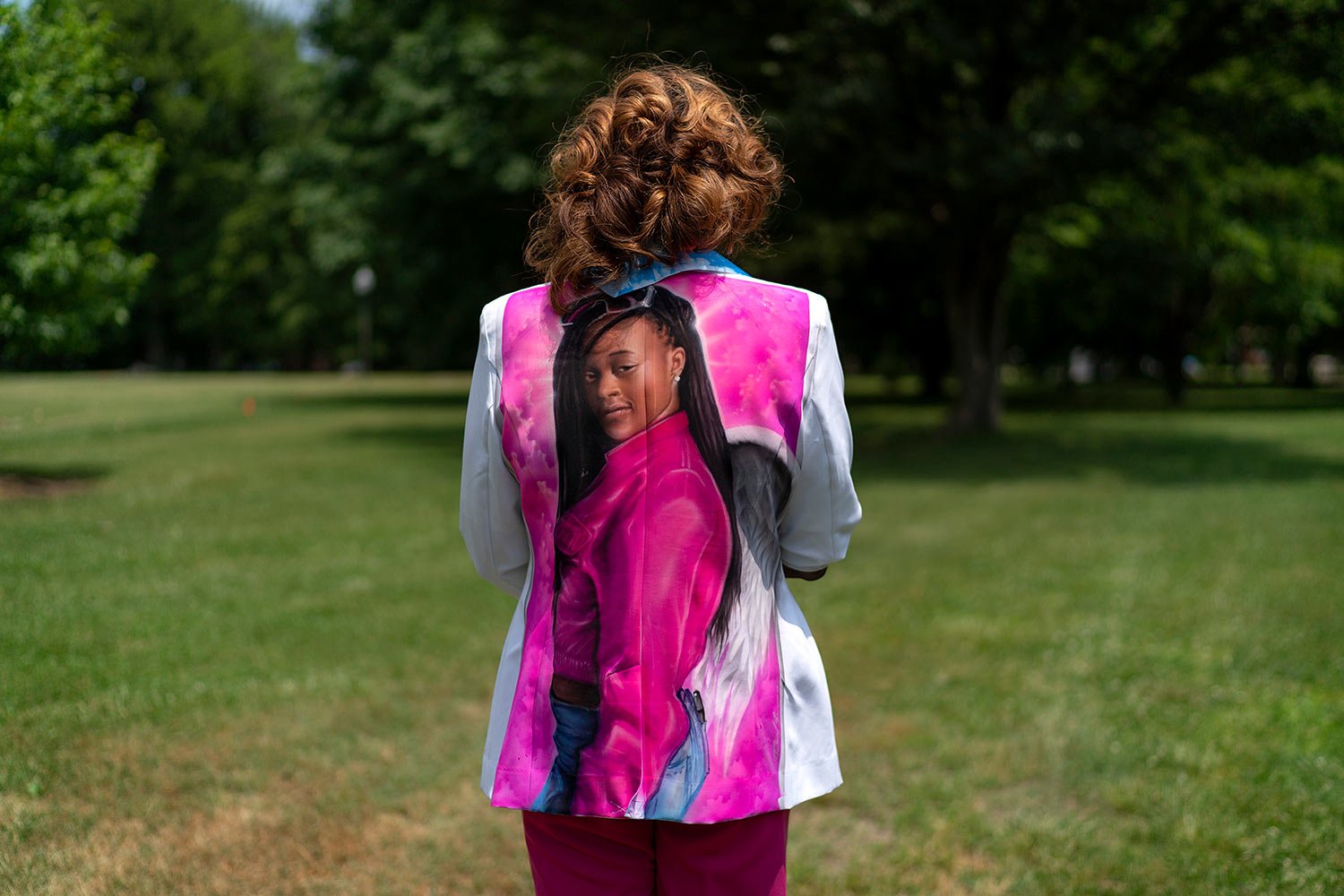
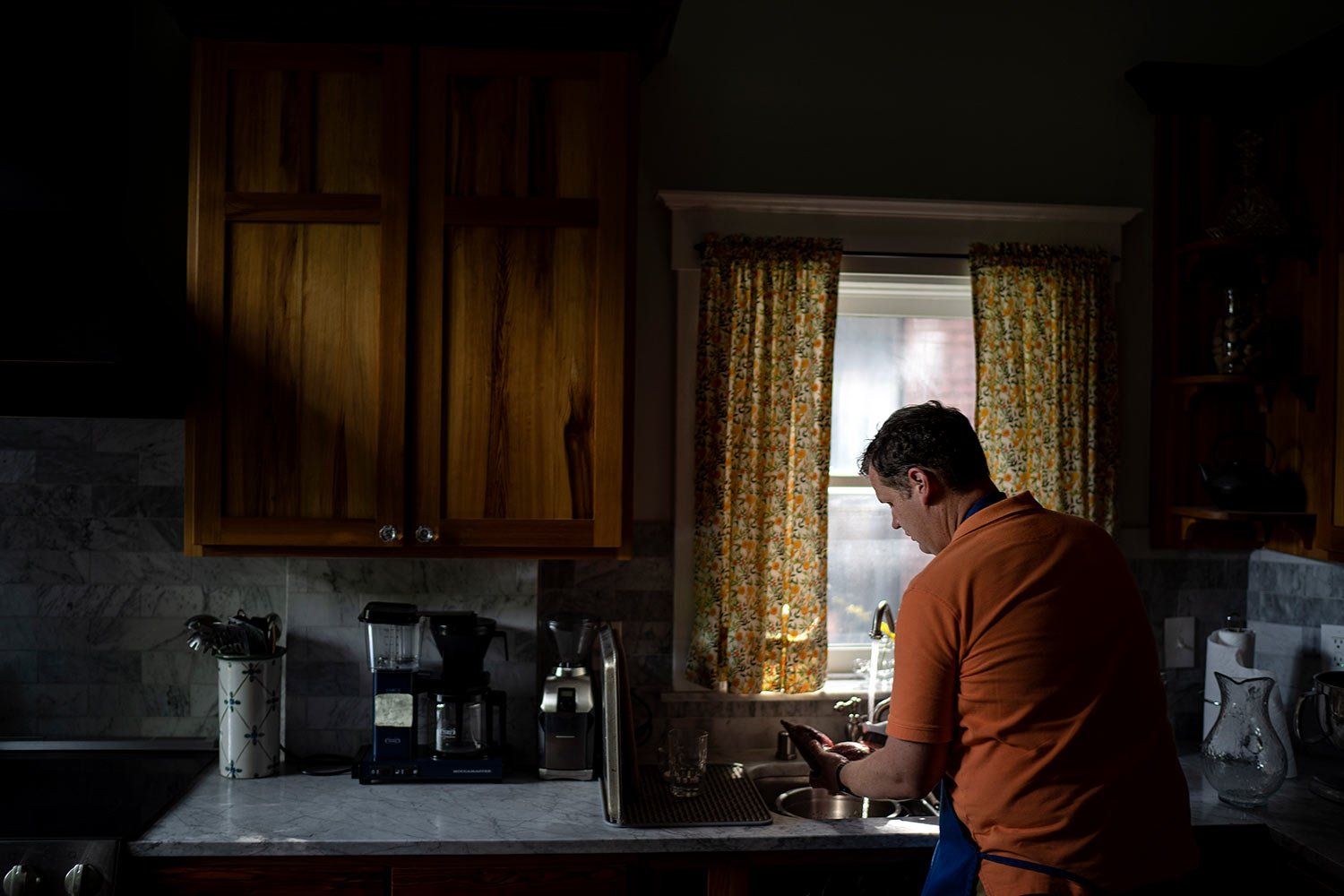
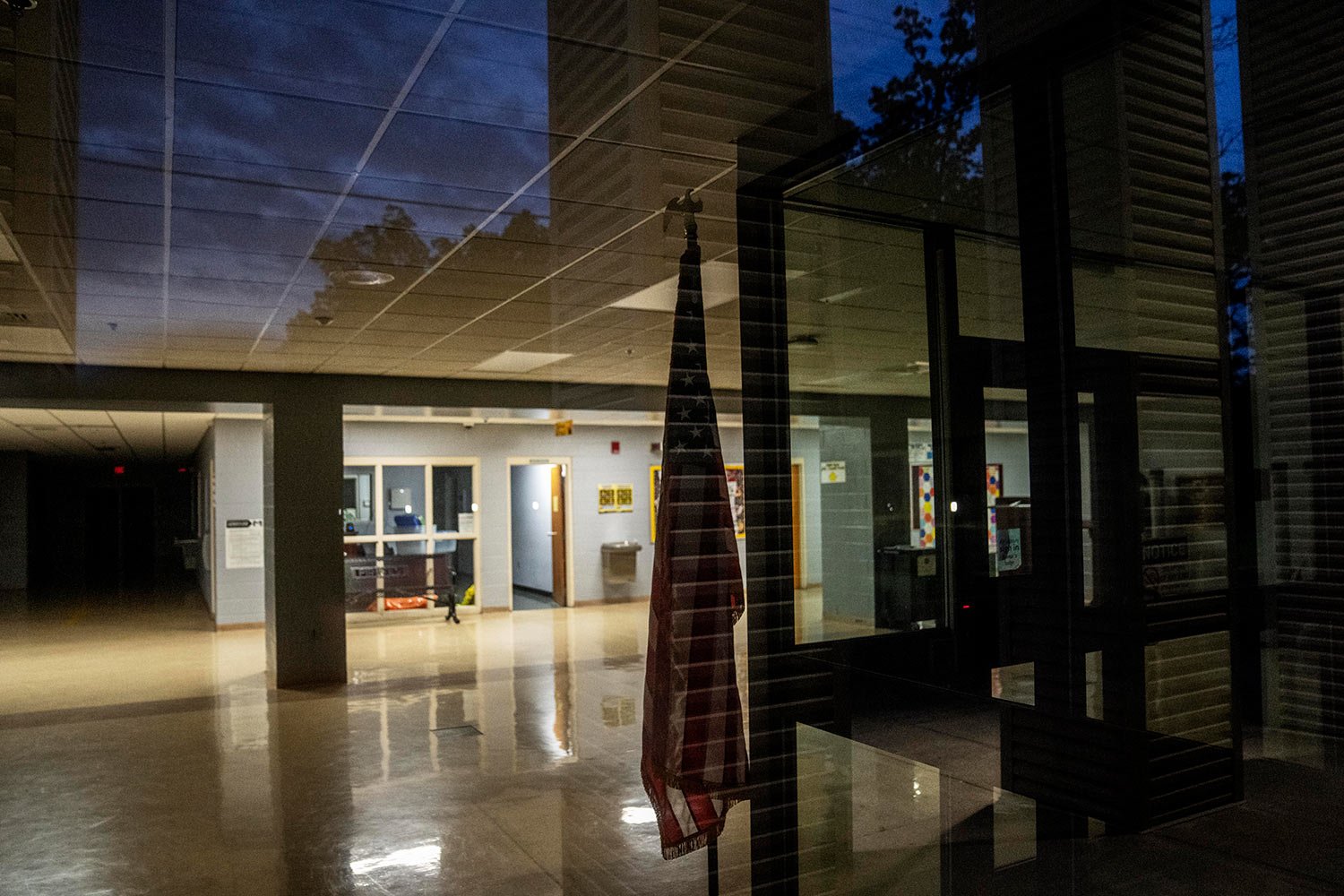
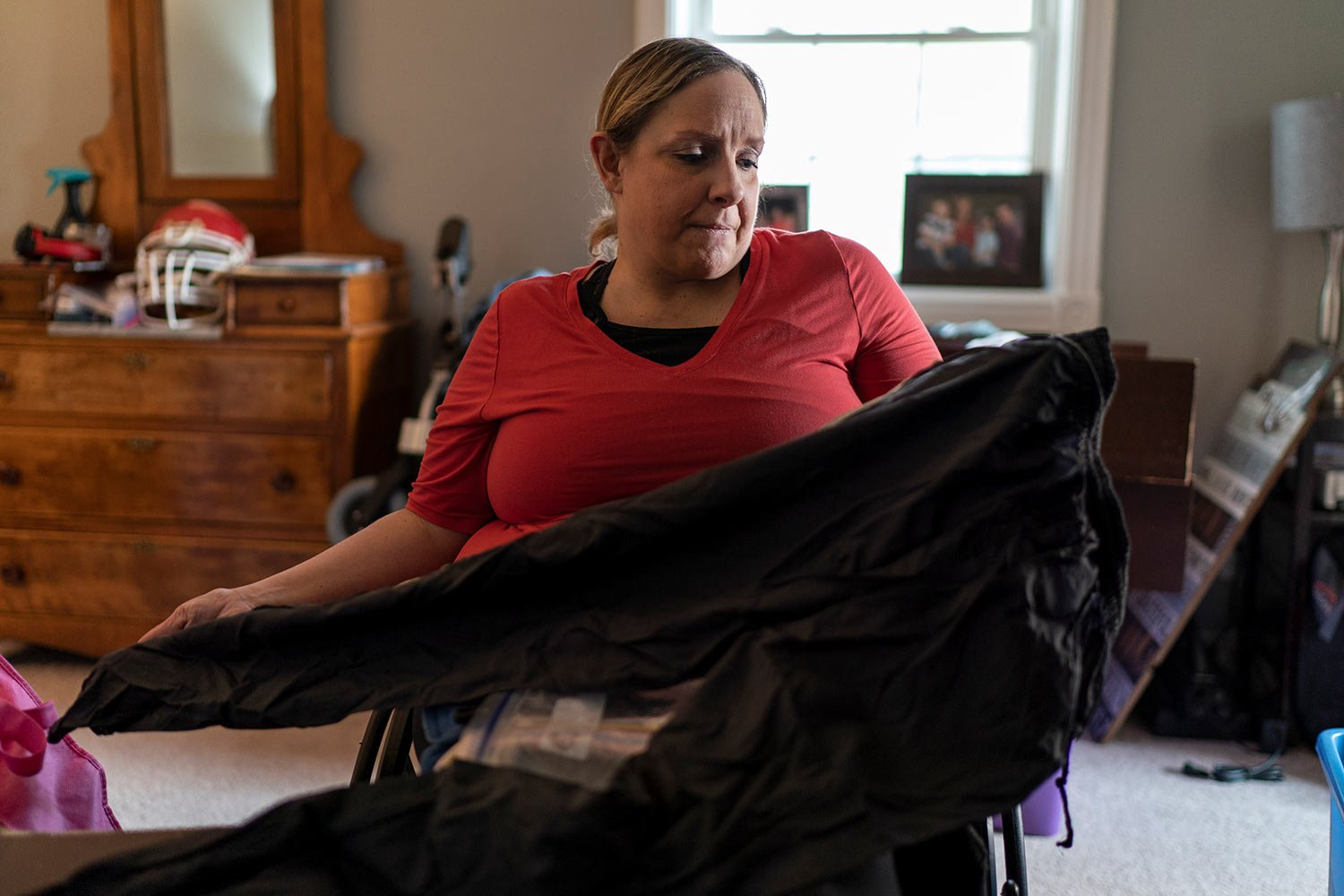
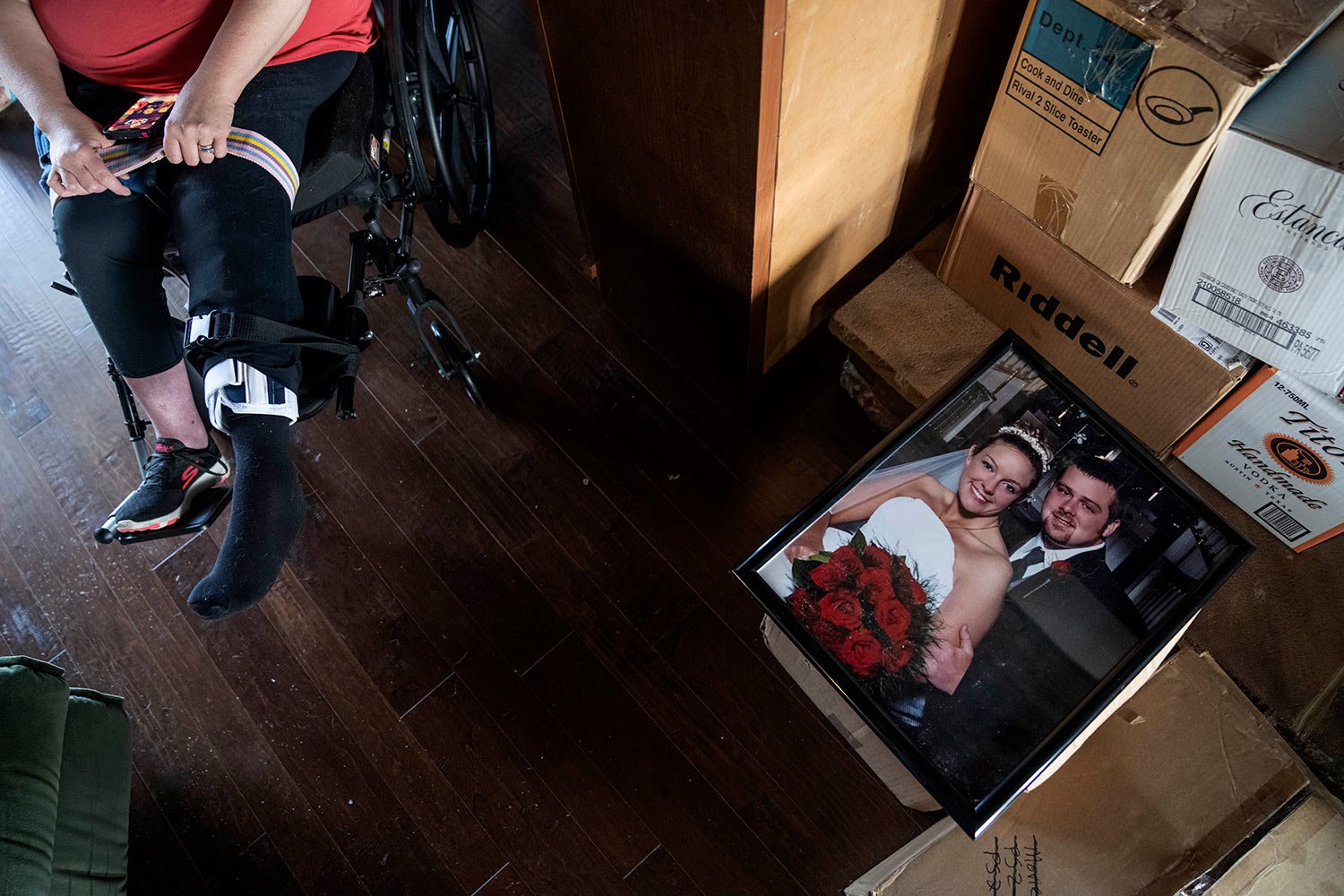
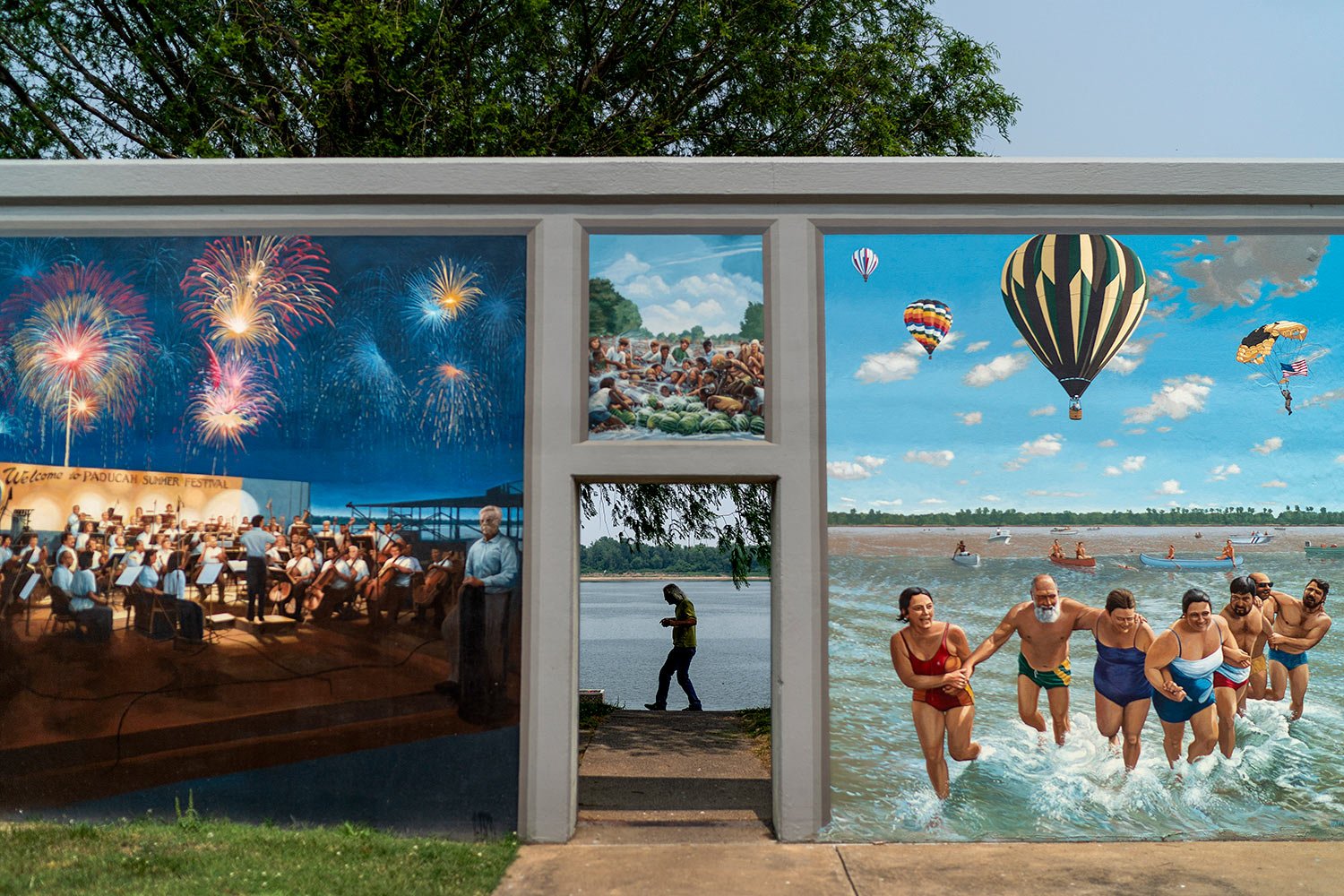
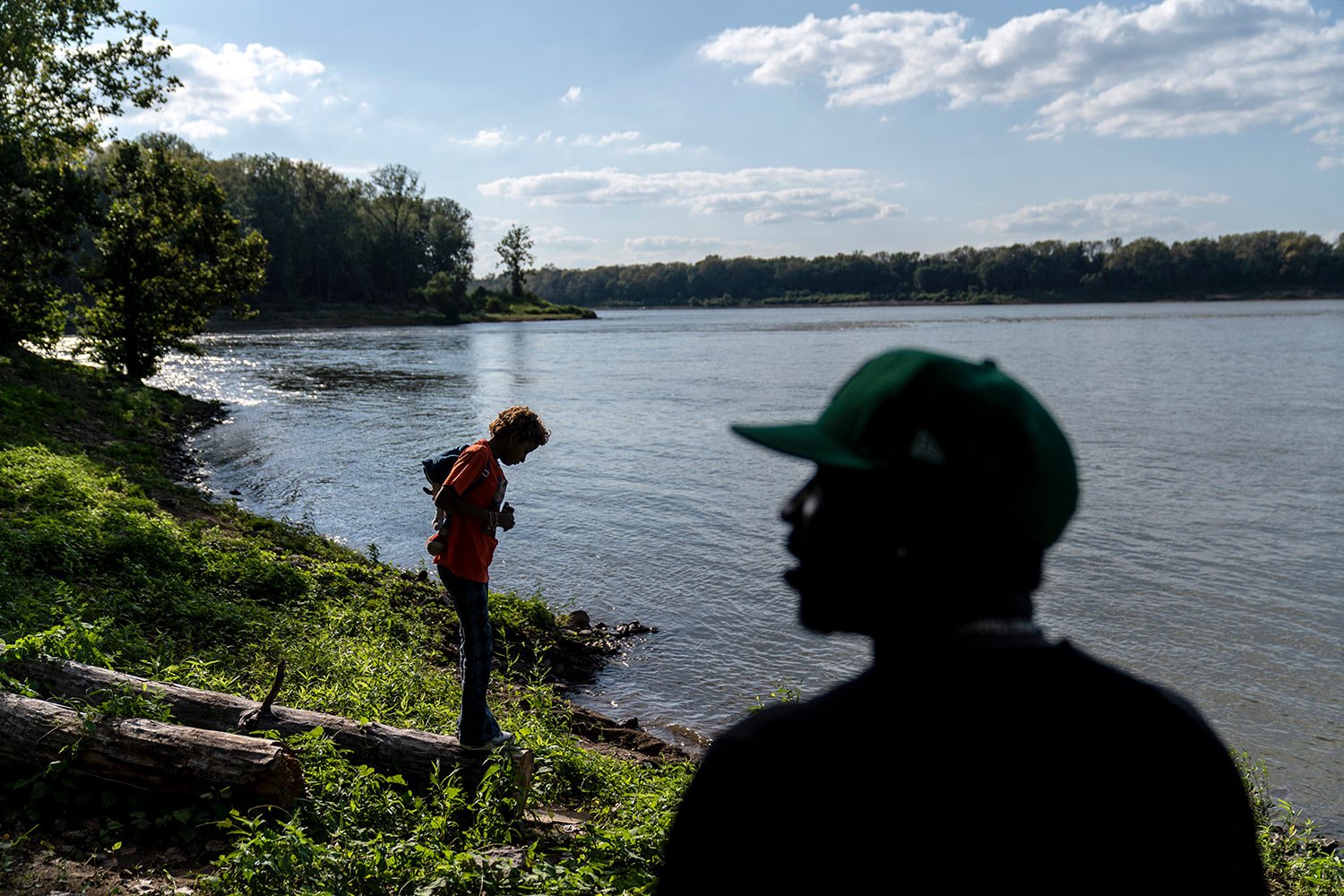

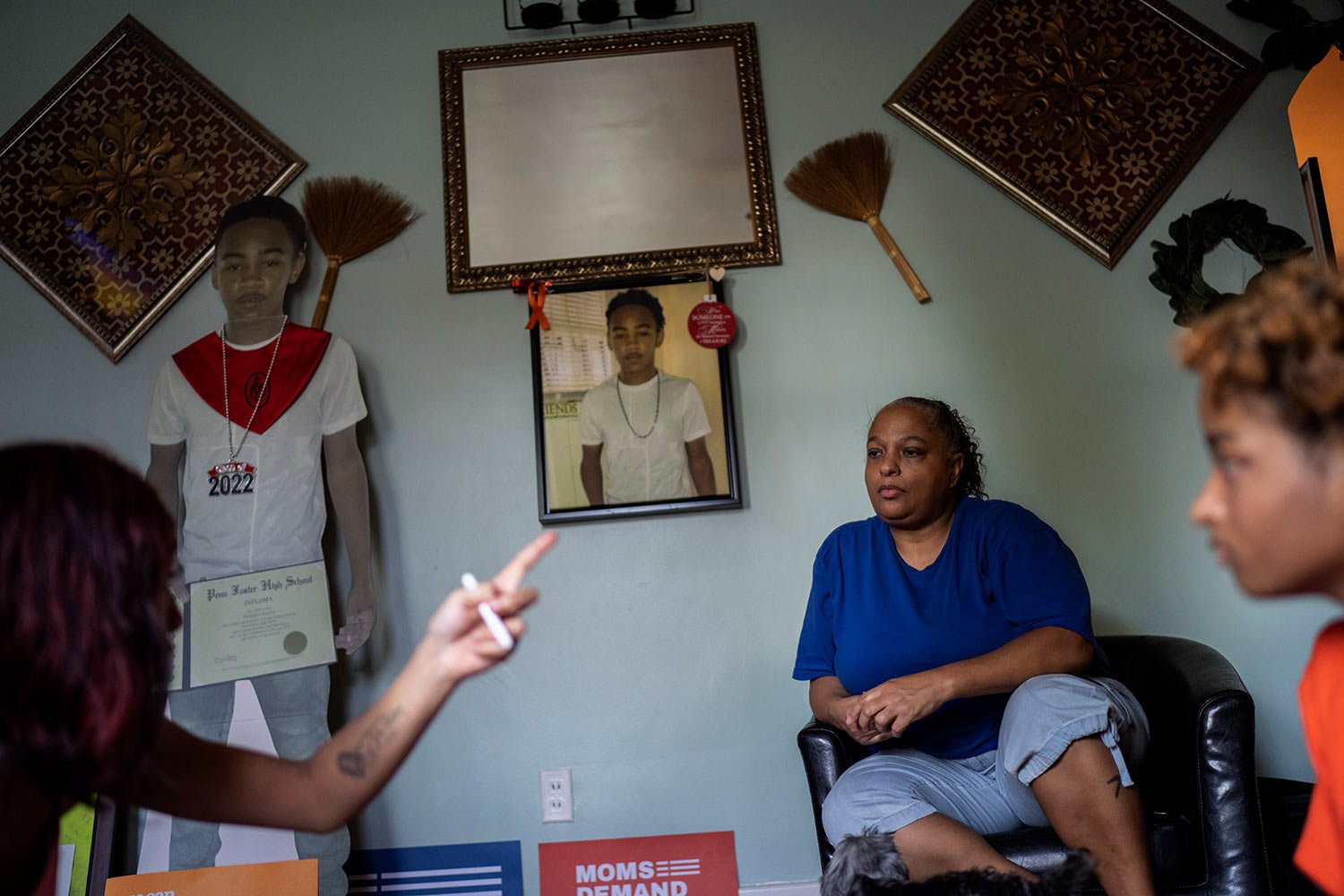
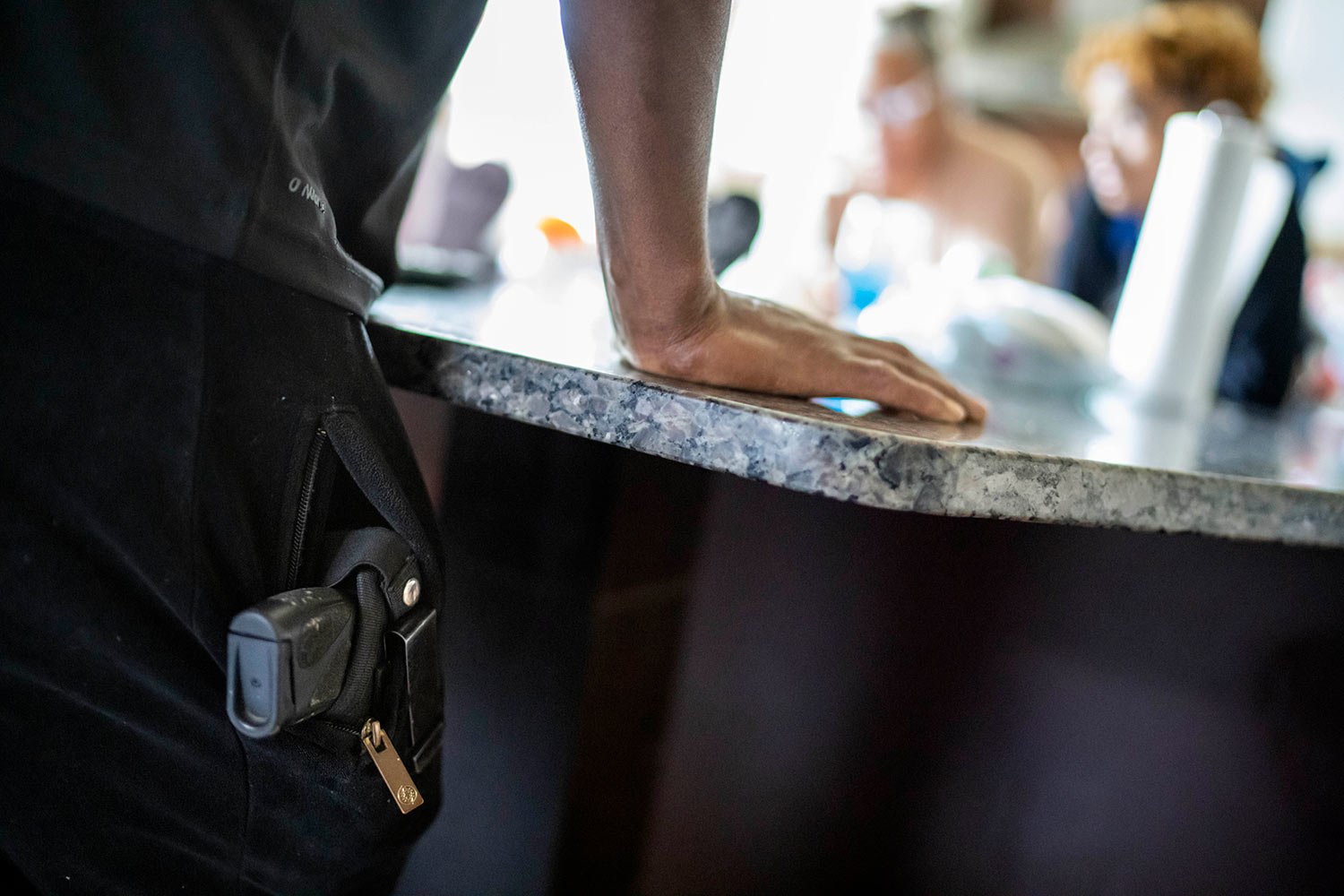
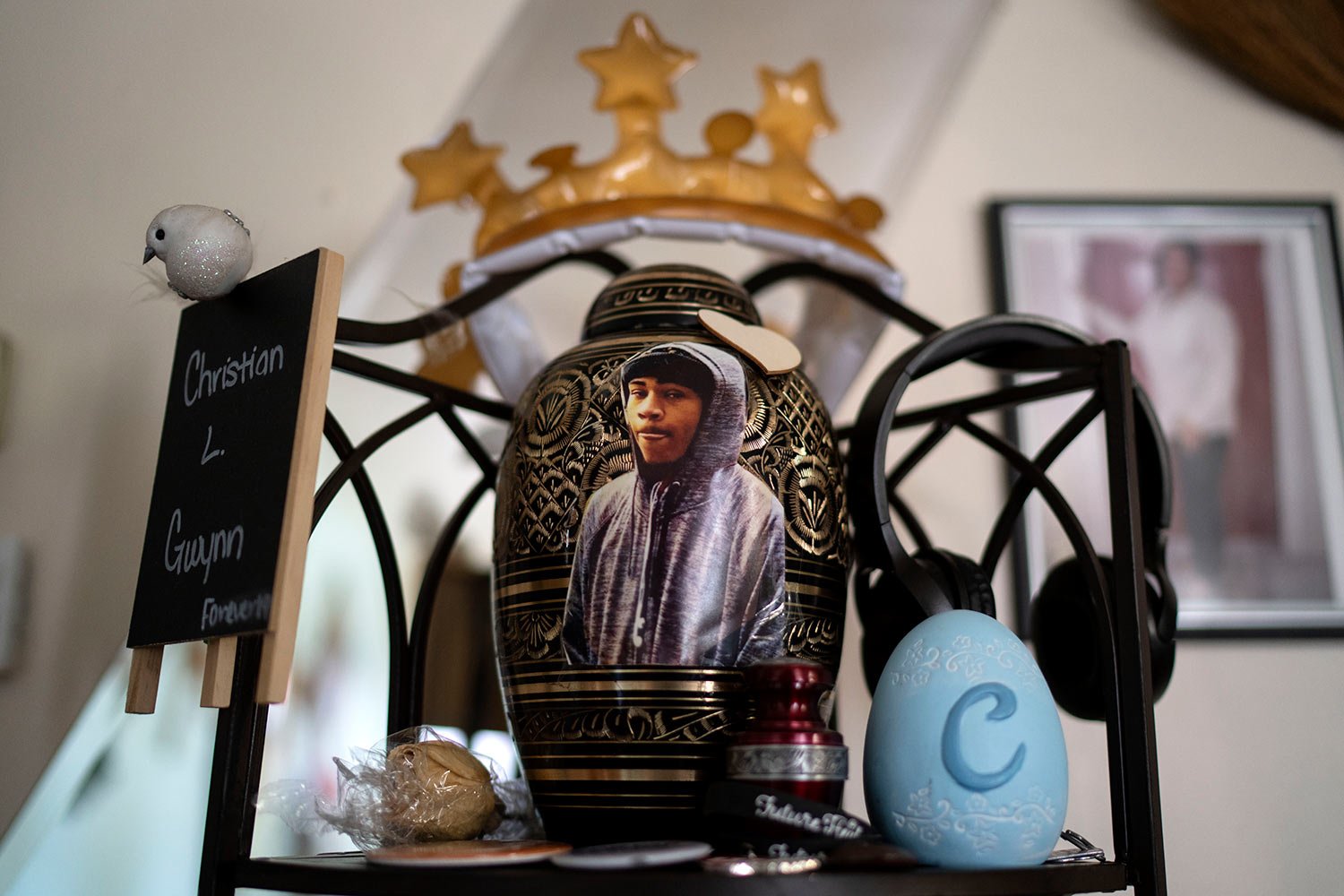
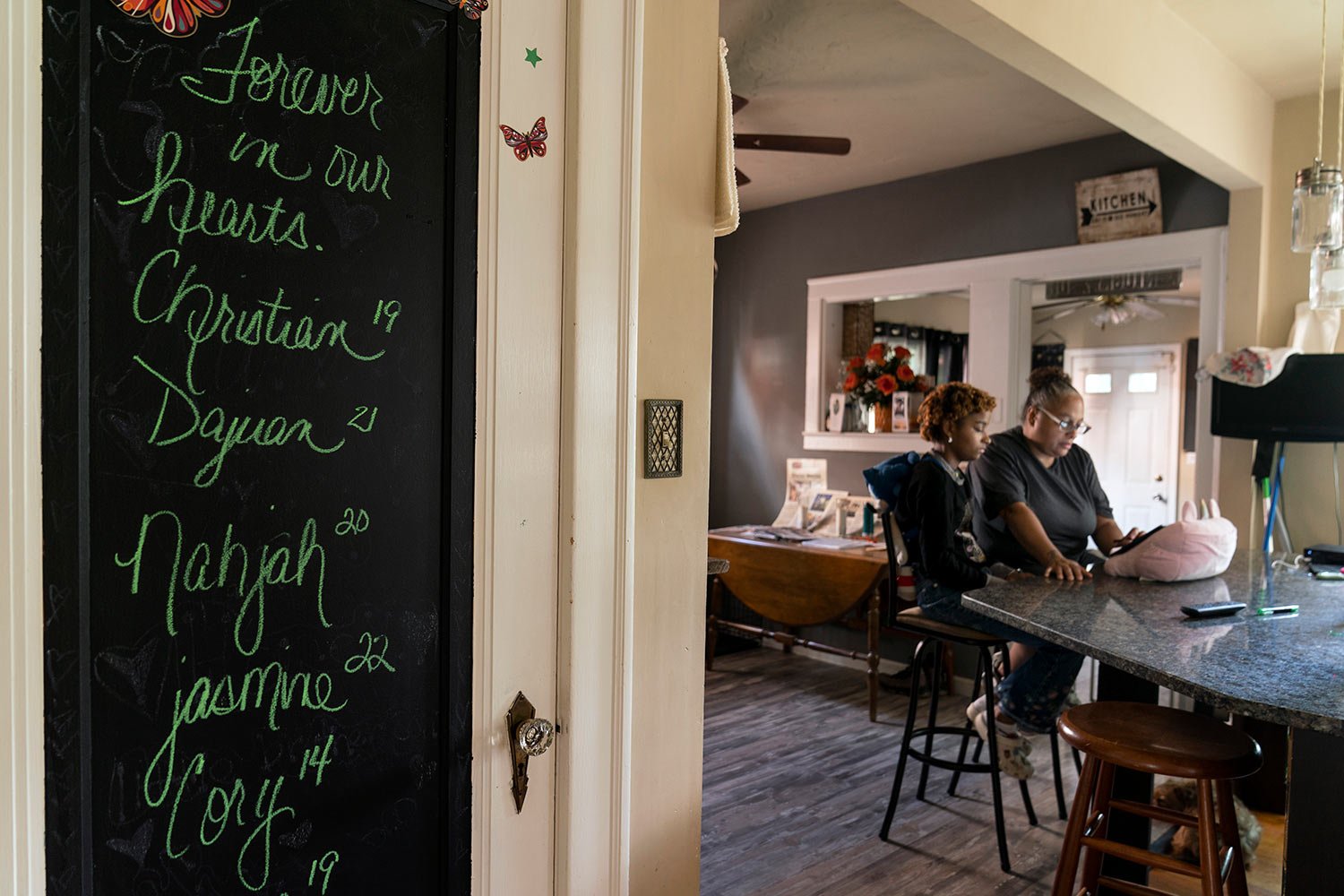
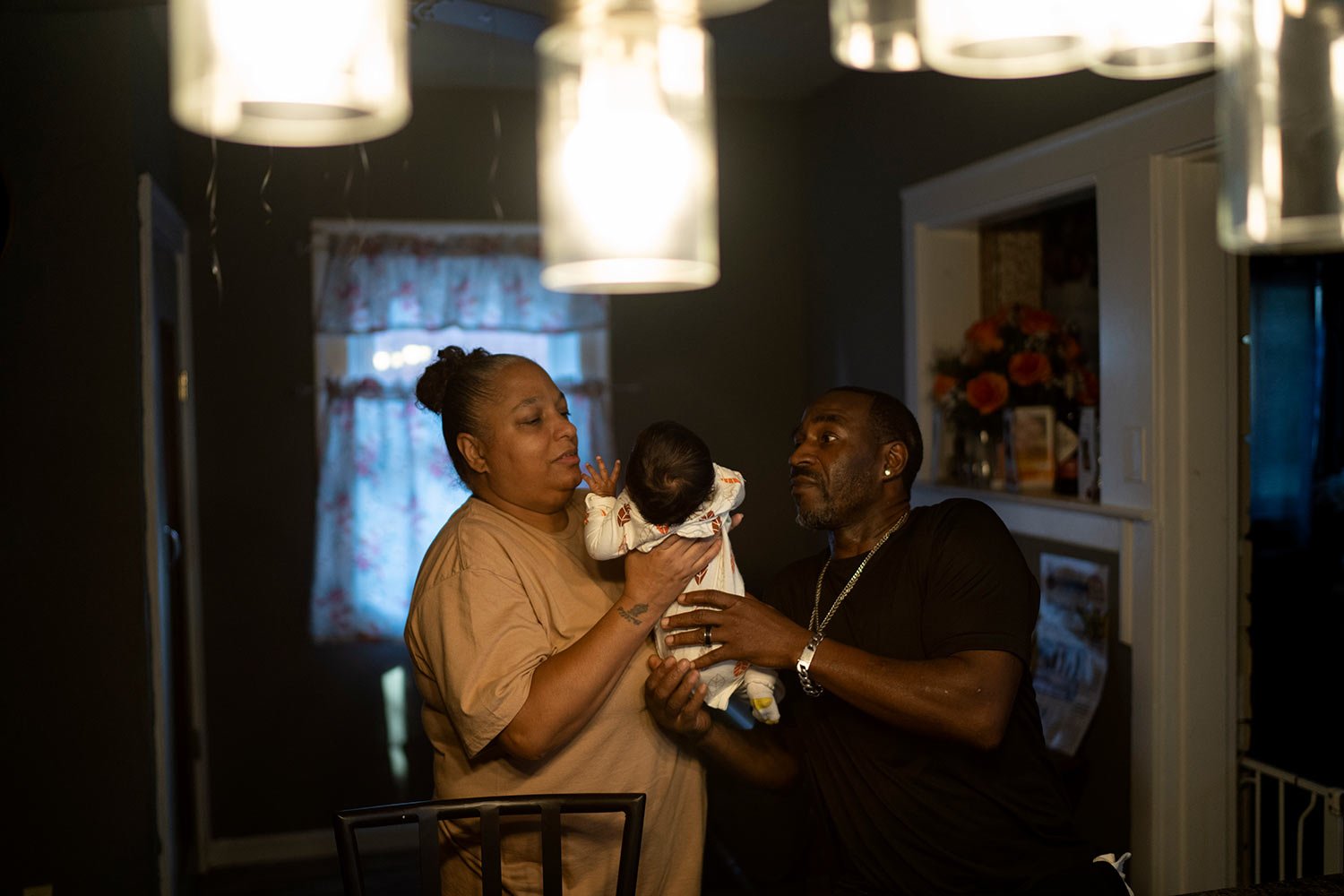

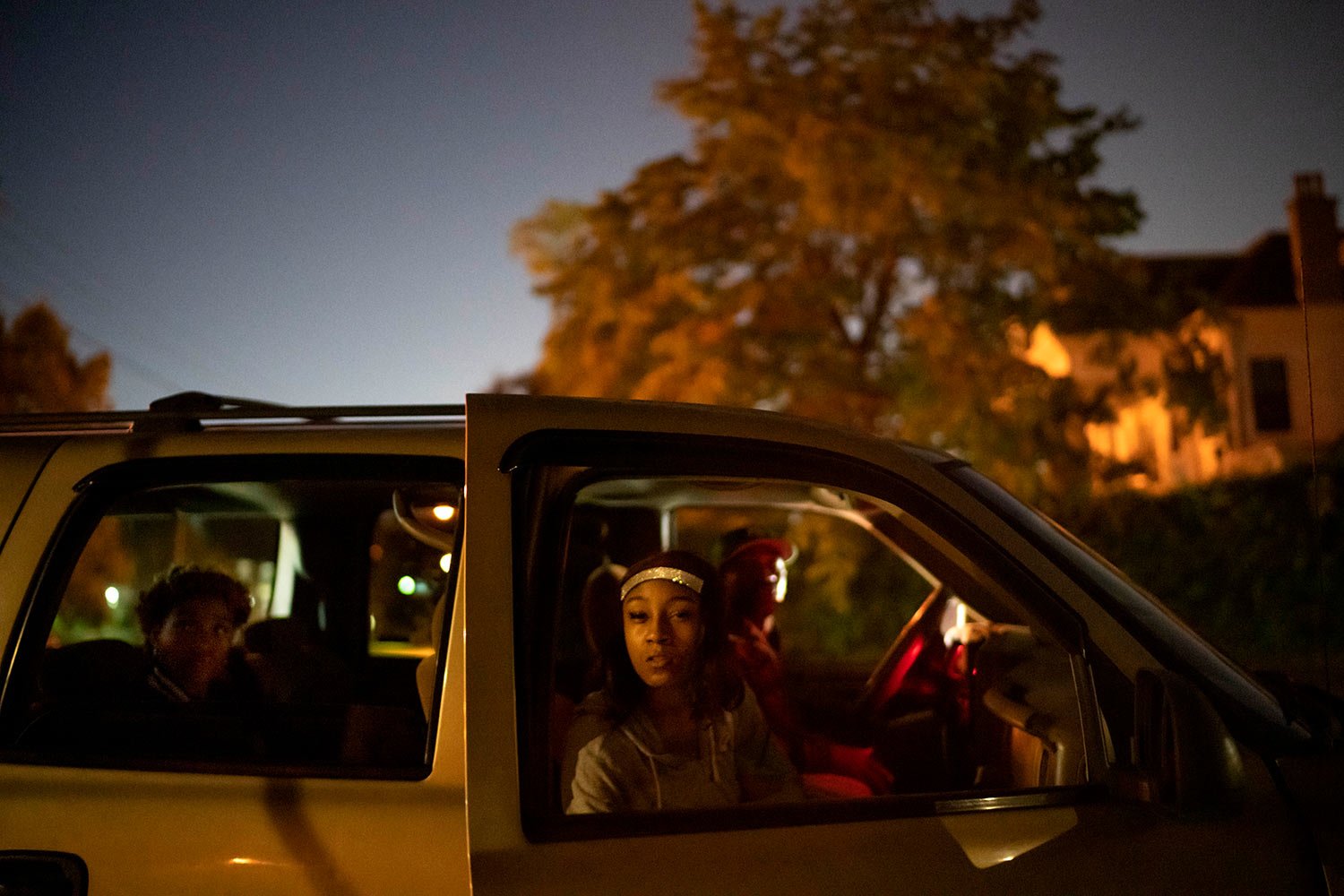
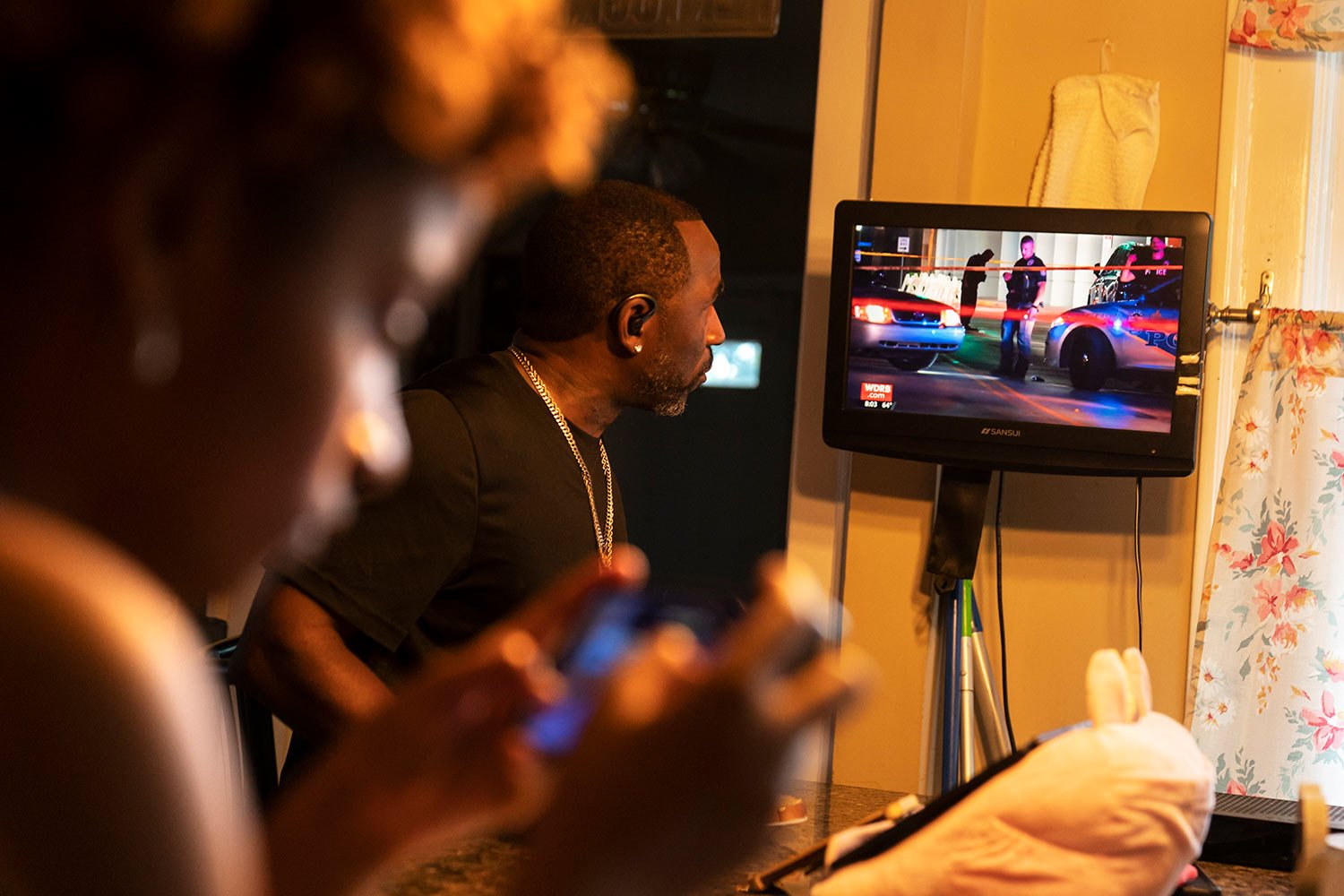
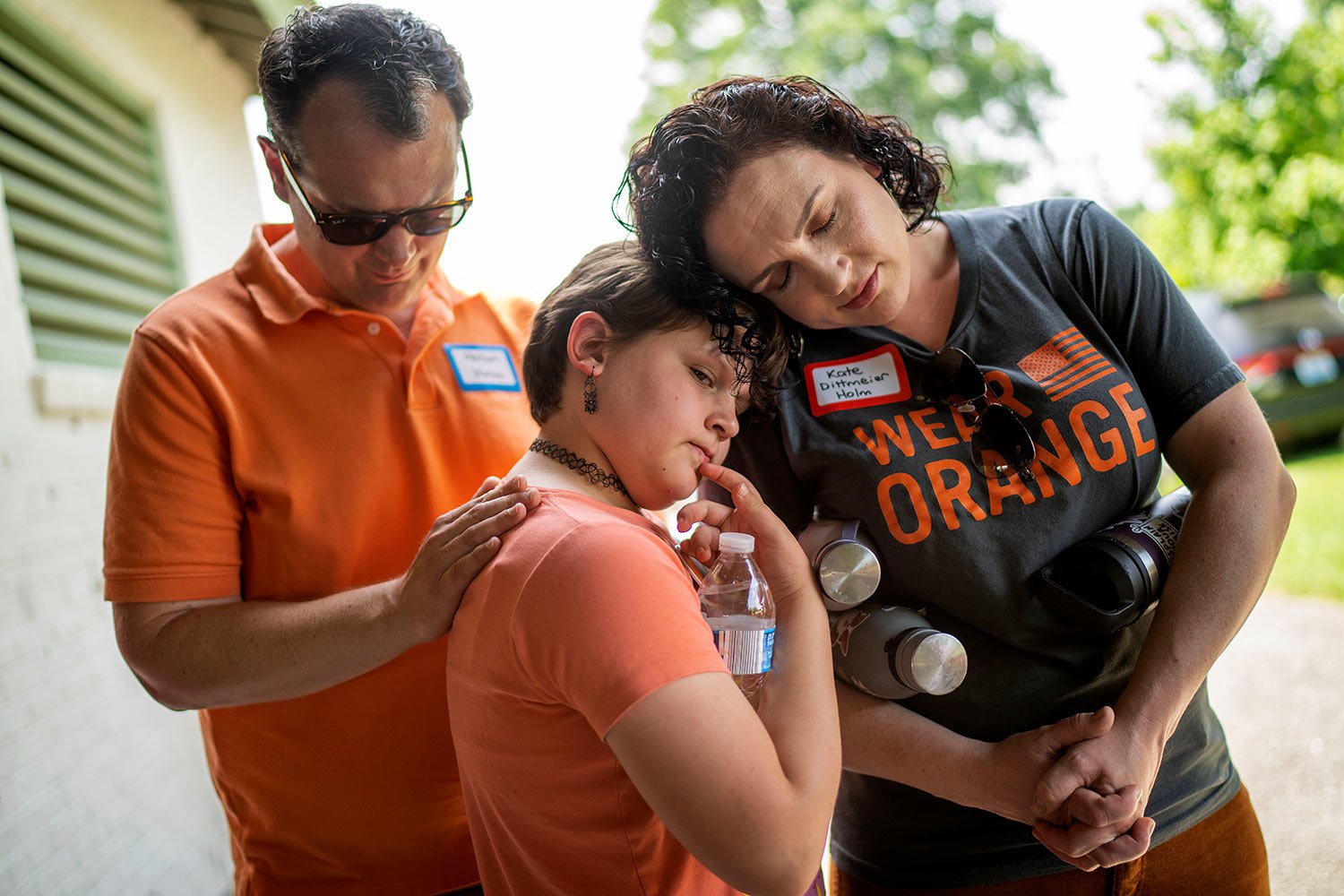
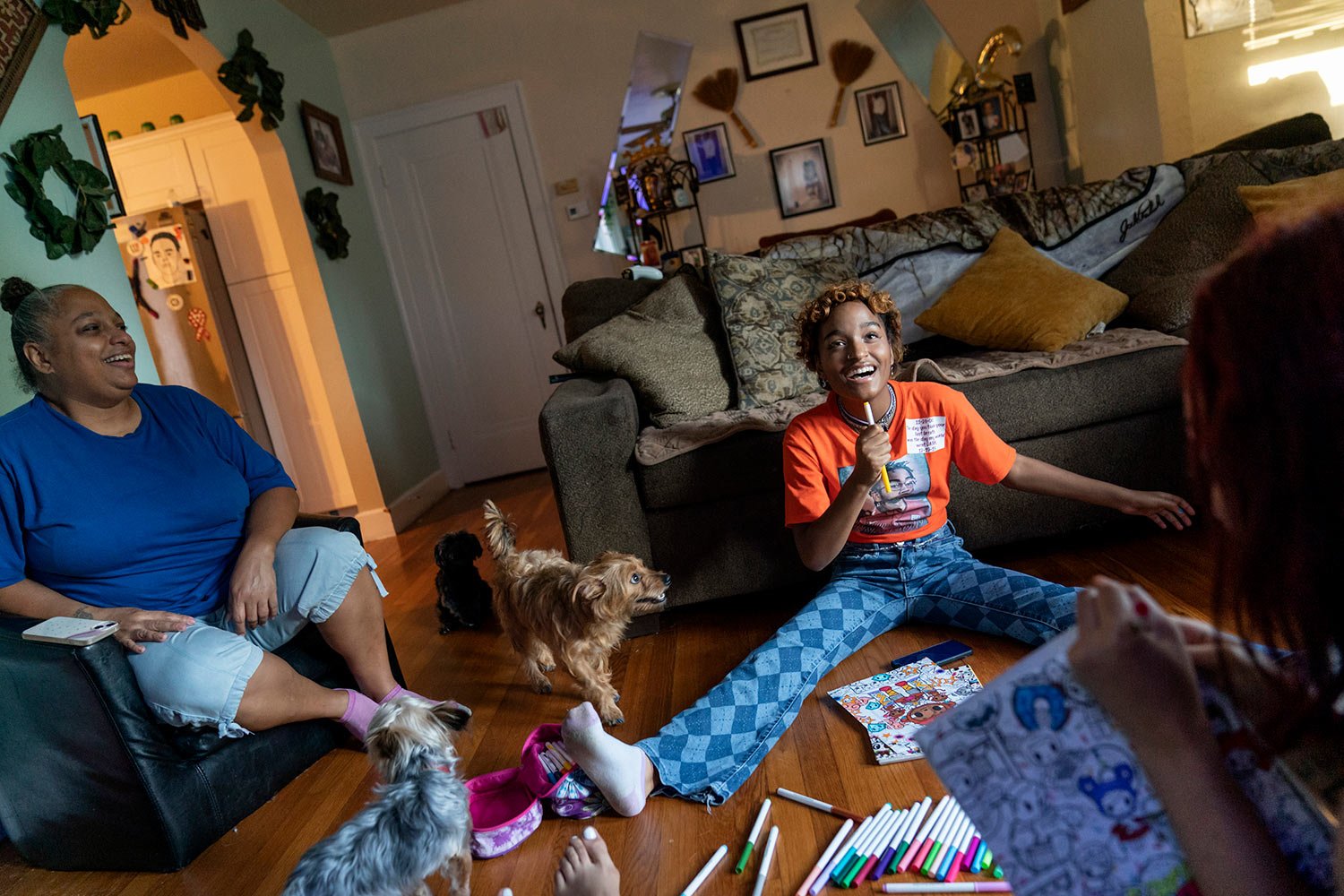
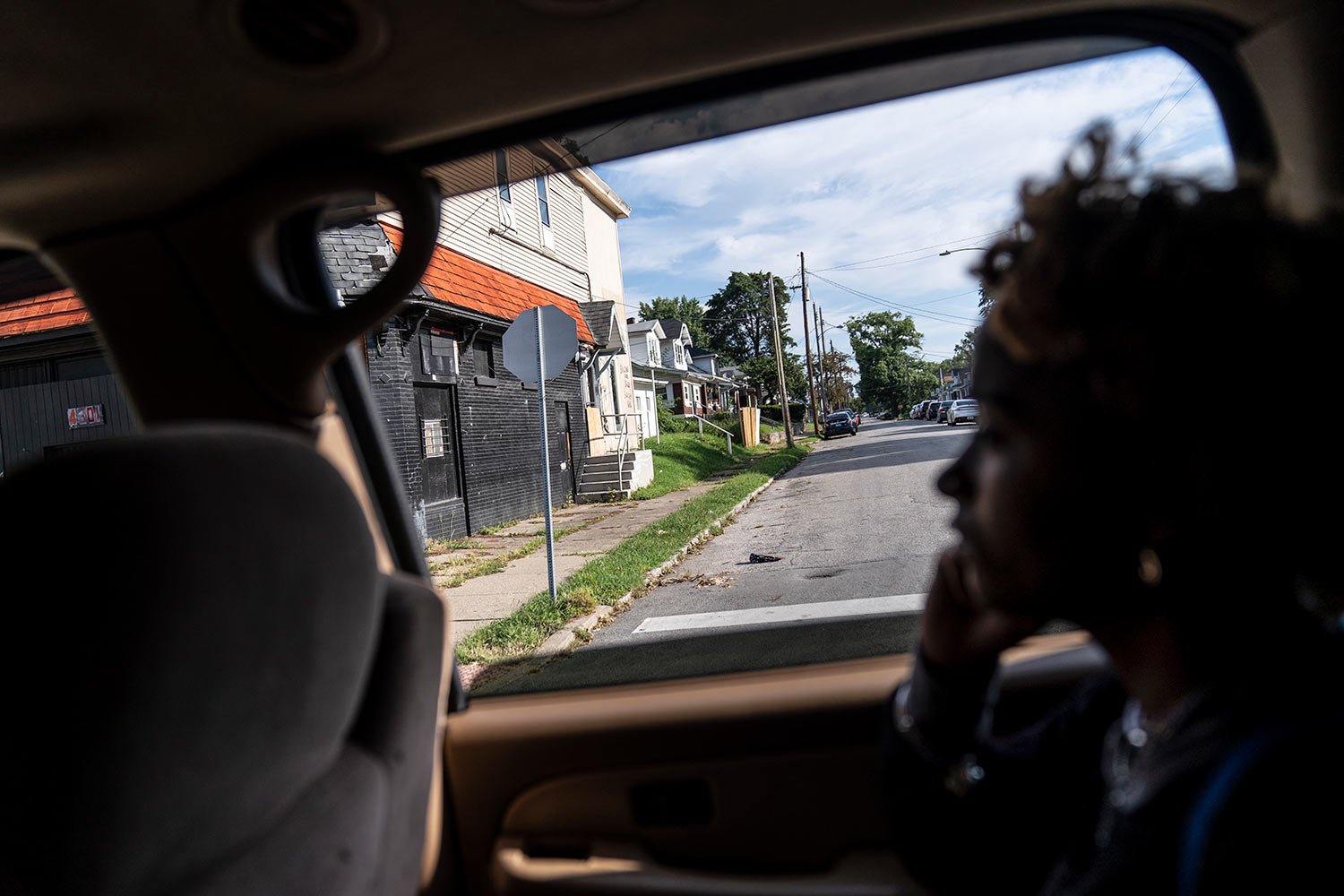

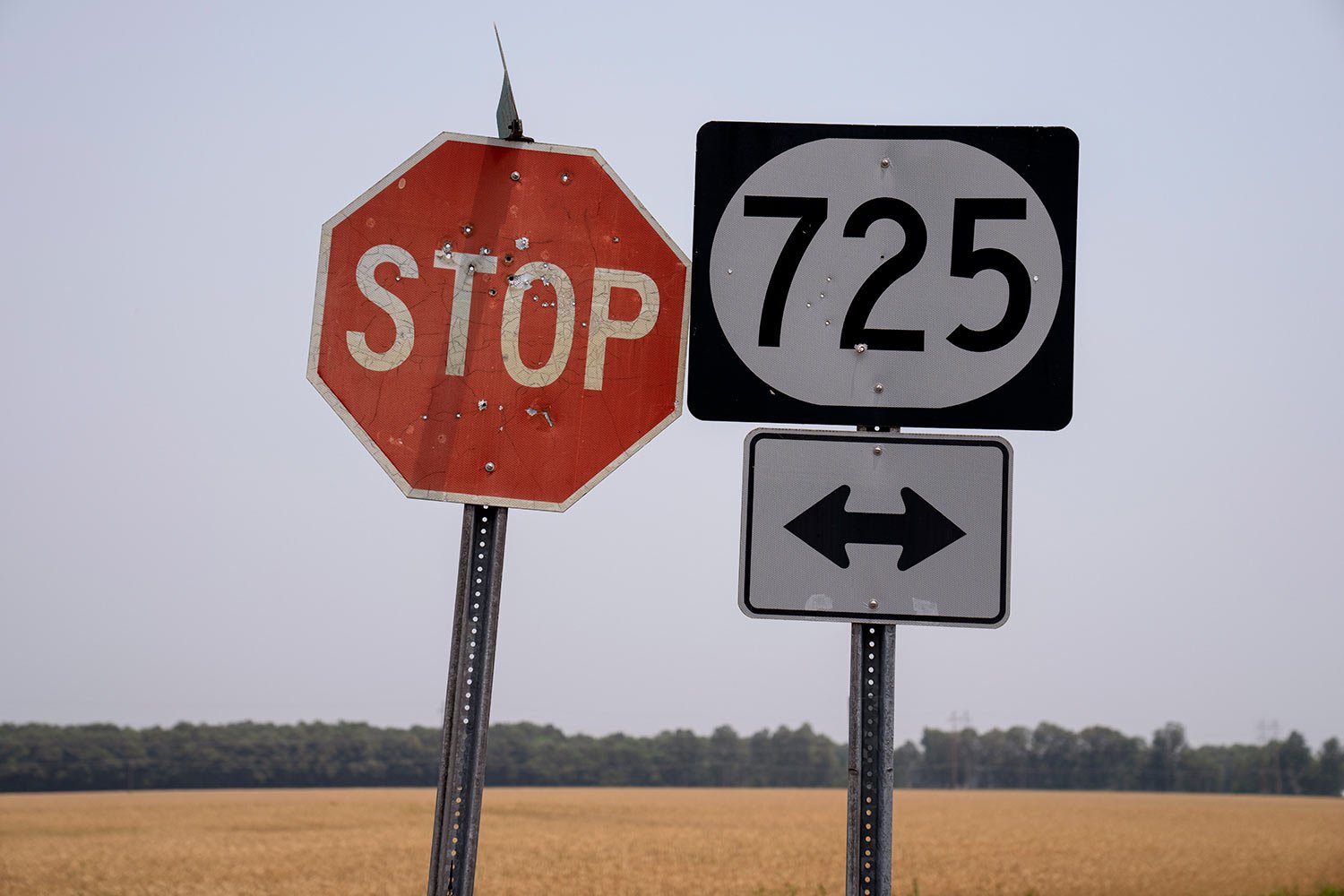
“Who wants to live with the fact that when I take my child to the park I have to watch every person who drives through?” Krista Gwynn says. “I have to listen to every conversation on the other side of the park that turns into an argument, because bullets don’t have a name.”
Today, at least, the loudest sound in the park are voices demanding change.
“Put down the guns! Save our sons!” the Gwynns and dozens of others chant, as they circle the park’s path. Near the back of the procession, Hollan Holm raises his voice louder when the heat starts wearing others down, with Kate and the kids seconding his call.
Before today the Holms and the Gwynns had met only once, the previous afternoon, when Hollan was asked to introduce Krista at a local Moms Demand Action event calling for tighter gun laws. But that was long enough for Gwynn to sense something.
“I feel like we are connected because now we are a group of survivors,” she says. “He shook my hand like he knew me.”
Victoria Gwynn, 21, looks out the window as a car she doesn’t recognize pulls up outside her home in Louisville, Ky., Monday, Aug. 28, 2023. (AP Photo/David Goldman)
Behind the Holms’ house, two miles from downtown Louisville, the deck looks over a large trampoline, girdled with a safety net. Kate and Hollan joke that for a pair of attorneys plenty familiar with the legal landmines of injury and liability, it’s a strange choice. But it reflects their thinking on parenting, not lawyering.
“There is some risk, but there is also a lot to be gained by letting them out into the world,” Kate says.
Some days, though, the world tests that decision.
On a Monday morning in April, Hollan Holm was putting his son and daughter on the school bus when seven or eight police cars sped by, sirens screaming. For a moment he was irritated that they’d blown past the bus stop sign. Then he realized how much the sounds echoed the emergency vehicles that converged on the school years before, when he was shot.
There was good reason. Just after 8:30 that morning, a gunman armed with an AR-15 rifle had walked into the Old National Bank downtown and killed five former co-workers.
During the week that followed, nine more people were shot to death in Louisville, a spasm of violence the city’s police department decried as “unconscionable.”
The day of the bank shooting, Hollan Holm’s fears about his children’s safety welled up. But he kept them to himself when he and Kate tried to answer their questions about what had happened.
“I try not to put that parental anxiety on the kids because that’s certainly the thing we carry,” he says.
That way they can just “be kids,” their days filled with theater camp and saxophone practice, graphic novels and Legos. But like kids everywhere, their awareness grows no matter how parents shield them.
Just before school ended last May, Sylvia Holm was looking forward to the fifth grade’s field trip to an entertainment arcade. That morning, she and her dad were driving to school when an interview came on the radio with the parents of Maite Rodriguez, one of the 19 children killed in last year’s mass shooting at Robb Elementary in Uvalde, Texas. They recalled their 10-year-old’s aspiration to one day become a marine biologist.
Sylvia Holm, 11, watches television after she attended a rally against gun violence with her family in Louisville, Ky., Saturday, June 3, 2023. (AP Photo/David Goldman)
“Dad didn’t really talk during the car ride after he heard that,” Sylvia says.
On the bus to the arcade, she started crying, thinking about how close in age the children in Uvalde were to the friends around her. Still, she says, if today’s children are going to find ways to stop school shootings when they grow up, it was better to know.
Kate, sitting beside her daughter at a park picnic table, smiles at the 11-year-old’s resolve.
“When I was her age I would think, ‘Oh, the grownups are going to solve this.’ And here’s she’s telling us, ‘We’re going to solve the problem,’” Kate says. But the expression on Sylvia’s face remains stone serious.
“Because the adults haven’t done enough,” she says.
The Associated Press receives support from several private foundations to enhance its explanatory coverage of elections and democracy. See more about the AP’s democracy initiative here. The AP is responsible for all content.
Text from the APNews story, For parents who’ve been through shootings, raising kids requires grappling with fears, by Adam Geller.

